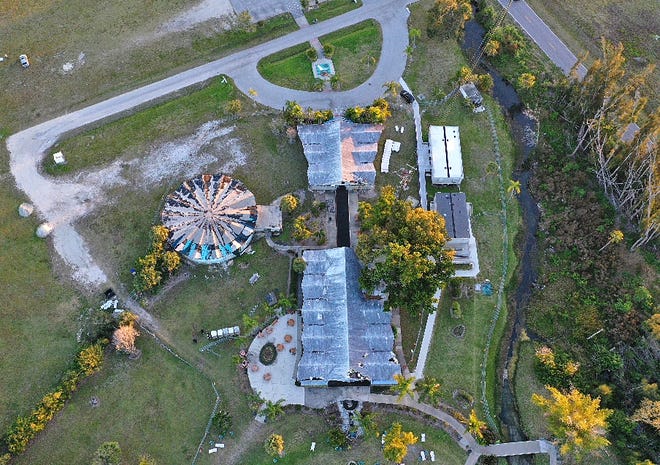
NORTH PORT — North Port leaders will discuss the future of Warm Mineral Springs Park on Tuesday, as recent reports indicate there are options to preserve all or some of the three historic buildings at the iconic facility damaged by Hurricane Ian 17 months ago.
Architectural and engineering reports filed in a Feb. 28 memo from Sweet Sparkman Architecture & Interiors indicate that all three historic buildings believed to have been designed by Jack West of the Sarasota School of Architecture could eventually be restored.
The city created its Local Historic Register specifically so that the three buildings at 12200 San Servando Street could be placed on the National Register of Historic Places. They obtained this status in 2019.
Ultimately, however, city commissioners will have to decide whether a historically faithful restoration is worth the cost.
The last official offer, received on June 6, 2022, was $17.6 million.
Since then, the sales buildings, spas and cyclorama suffered significant damage when Hurricane Ian made landfall on September 28, 2022.

The three buildings built for Florida's Quaternary are located on the 21.6-acre Warm Mineral Springs Historic Site.
The commission will also discuss more options for the 61.4-acre parks surrounding the tourist areas since the city and Warm Mineral Springs Development Group recently finalized plans for a public-private partnership.
As part of this partnership, the WMS Development Group had the three structures refurbished and commissioned the springs. It was also intended that a hotel, residences, and other amenities would be built in the surrounding parks.
For the 2020-22 three-year period, the park had a net profit of more than $2 million but in the 2022-2023 fiscal year, which included the impact of Hurricane Ian and subsequent closure, it lost $208,138, taking in $644,087 compared to $852,115 in expenses.

In the first three months of the 2023-24 fiscal year, which runs from Oct. 1 through Sept. 30, the park brought in $447,501 for $290,163 in expenses.
The committee meets at 10 a.m. March 5 at City Hall, 4970 City Hall Blvd.
What do you do with historic buildings?
Hurricane Ian left the sales and spa buildings in poor condition and the cyclorama in moderate to poor condition, according to a report by engineering consultancy Snell.
Combined, the three buildings represent 13,775 square feet of covered area – 3,370 square feet for the sales building; 6.055 for the spa building and 4.350 for the sclorama.
The original renovation plan, developed by Sweet Sparkman and Kimley Horne, included demolishing the structures to their “historic bones,” making major structural repairs, replacing all windows, as well as mechanical electrical and plumbing systems, and installing fire sprinklers. The system, according to a memo from John W. Bryant, Sweet Sparkman's vice president.

All three buildings were constructed using ceramic-faced structural clay tiles.
These tiles are not readily available and are likely to be produced by a company that specializes in clay tiles from custom-made molds.
Also at that time, the structures were not located in what the Federal Emergency Management Administration considered a high-risk flood zone.
As of March 27, 2024, they will be in a FEMA high-risk flood zone. Hurricane Ian left a line of flood water measuring 14 to 16 inches above the end floors.
Floodwaters also likely will cause further deterioration of exposed structural steel columns, many of which were retained in the original renovation plan, Bryant wrote. Flood damage may replace more people.

Bryant wrote that the buildings could be renovated at their current flood height, but in this case he suggested upgrades, including removable flood barriers at all doors; Raise all mechanical equipment 24 inches above grade; – Raise all electrical outlets 24 inches above the finished floor; And no permeable surface or drywall within 24 inches of the finished floor.
All of these suggestions would increase the total cost.
What are the options?
The first option, a complete historic renovation, could cost between $800 and $950 per square foot. The buildings would not need to be taller due to an exemption from the historic building code.
With that in mind, Bryant noted that the potential construction cost ranges between $11 million and $13.1 million. This does not include design fees and site construction costs, as well as extending water and sewer to the three buildings, which were part of the original $17.6 million Phase One bid.
The second option is a partial historic renovation of the complex, with only one of the three buildings being historically restored. The cyclorama—one of three in the United States and about 30 worldwide—is the most likely candidate in this scenario.
Bryant noted that more research needs to be done to see if raising the other two buildings jeopardizes the third building's historic designation and exemption from the historic building code.
While Bryant pegged the cost of historic renovation in the range of $800 to $950 per square foot, he estimated the cost of new construction at $650 to $800 per square foot.
This puts the potential historic renovation cost of the Cyclorama between $3.5 million and $4.1 million, excluding design and site construction costs.
A third option would be to raise the three structures and replace them with new facilities at a cost of $650 to $800 per square foot.


